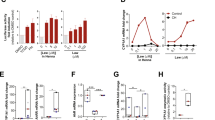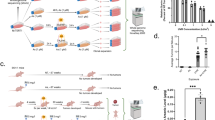Abstract
2,3,7,8-Tetrachlorodibenzo-p-dioxin (TCDD) serves as the prototype for a group of environmental toxicants, the halogenated aromatic hydrocarbons1–3, which evoke a characteristic pattern of acute toxic and biochemical responses, and which produce these effects by stereospecific and reversible binding to a soluble protein receptor2,4,5. The chronic administration of TCDD6–9 (and several other halogenated aromatic hydrocarbons)10–13 to rats and mice has produced an increased incidence of hepatocellular carcinomas as well as tumours in other tissues. However, because TCDD is not a mutagen14,15 and does not bind appreciably to DNA in vivo16, it has been suggested that this compound is not a complete carcinogen, but rather acts as a tumour promoter, enhancing neoplastic expression in already initiated cells17,18. TCDD has been shown to be a potent tumour promoter in a two-stage model of carcinogenesis in rat liver19, but has proven ineffective in the classical model in mouse skin (using CD-1 and Swiss-Webster mice)20,21. We have recently shown that TCDD produces epidermal hyperplasia and hyper-keratosis, and squamous metaplasia of the sebaceous glands in mice bearing the recessive trait, hairless (hr), but causes no changes in the skin of mice which are wild type or heterozygous at this locus22. Here we examine the capacity of TCDD to promote tumour formation in the skin of HRS/J hairless (hr/hr) mice and their congeneic, haired (hr/+) littermates. Following the application of an initiating dose of a carcinogen, repeated skin application of TCDD produced papillomas in hr/hr mice but not hr/+ mice. In HRS/J hairless mice, tumour promotion by TCDD elicits the same incidence and multiplicity of skin papillomas as does the classical tumour .promoter, 12-O-tetradecanoylphorbol-13-acetate (TPA), but at l/100th the dose.
This is a preview of subscription content, access via your institution
Access options
Subscribe to this journal
Receive 51 print issues and online access
$199.00 per year
only $3.90 per issue
Buy this article
- Purchase on Springer Link
- Instant access to full article PDF
Prices may be subject to local taxes which are calculated during checkout
Similar content being viewed by others
References
Kimbrough, R. (ed.) Halogenated Biphenyls, Terphenyls, Naphthalenes, Dibenzodioxins and Related Products (Elsevier, Amsterdam, 1980).
Poland, A. & Knutson, J. C. A. Rev. Pharmac. Tox. 22, 517–554 (1982).
Goldstein, J. A. in Halogenated Biphenyls, Terphenyls, Naphthalenes, Dibenzodioxins and Related Products (ed. Kimbrough, R.) 151–190 (Elsevier, Amsterdam, 1980).
Poland, A., Glover, E. & Kende, A. S. J. biol. Chem. 251, 4936–4945 (1976).
Poland, A., Greenlee, W. F. & Kende, A. S. Ann. N. Y. Acad. Sci. 320, 214–230 (1979).
Kociba, R. J. et al. Tox. appl. Pharmac. 46, 279–303 (1978).
National Toxicology Program Natn. Tox. Progm. tech. Rep. Ser. 209, (NTP-80-31, NIH Publ. 82-1765, 1982).
Van Miller, J. P., Lalich, J. J. & Allen, J. R. Chemosphere 9, 537–544 (1977).
Toth, K., Somfai-Relle, S., Sugar, J. & Bence, J. Nature 278, 548–549 (1979).
IARC Monographs on the Evaluation of the Carcinogenic Risk of Chemicals to Humans 18 (1977); 20 (1978).
NCI/NTP Bioassay of 2,7-Dichlorodibenzo-p-dioxin for Possible Carcinogenicity (HEW TR123, 1979).
NCI/NTP Bioassay of a Mixture of 1,2,3,6,7,8- and 1,2,3,7,8,9-Hexachlorodibenzo-p-dioxin for Possible Carcinogenicity (TR198 & 202 HEW, 1980).
Kimbrough, R. D. et al. J. natn. Cancer Inst. 55, 1453–1459 (1975).
Wassom, J. S., Huff, J. E. & Loprieno, N. Mutat. Res. 47, 141–160 (1977/1978).
Geiger, L. E. & Neal, R. A. Tox. appl. Pharmac. 59, 125–129 (1981).
Poland, A. & Glover, E. Cancer Res. 39, 3341–3344 (1979).
Boutwell, R. K. Prog. exp. Tumor Res. 4, 207–250 (1964).
Hecke, E., Fusenig, N. E., Kunz, W., Marks, F. & Thielmann, H. W. (eds) Carcinogenesis Vol. 7 (Raven, New York, 1982).
Pitot, H. C., Goldsworthy, T., Campbell, H. A. & Poland, A. Cancer Res. 40, 3616–3620 (1980).
Berry, D. L. et al. Res. Commun. chem. Path. Pharmac. 20, 101–107 (1978).
Natn. Tox. Prog. tech. Rep. Ser. 201, (NTP 80–32 NIH Publ. 82–1757, 1982).
Knutson, J. C. & Poland, A. Cell 30, 225–234, 1982.
Green, M. C. Biology of the Laboratory Mouse (ed. Green, E. L.) 87–150 (McGraw-Hill, New York, 1966).
Digiovanni, J., Slaga, T. J. & Boutwell, R. K. Carcinogenesis 1, 381–389 (1980).
Poland, A. & Glover, E. Molec. Pharmac. 13, 924–928 (1977).
Knutson, J. C. & Poland, A. Cell 22, 27–36 (1980).
Decad, G. M., Birnbaum, L. & Matthews, H. B. Tox. appl. Pharmac. 59, 564–573 (1981).
Brinkman, U. A. & De Kok, A. in Halogenated Biphenyls, Terphenyls, Naphthalenes, Dibenzo-p-dioxins and Related Products (ed. Kimbrough, R.) 109–150 (Elsevier, Amsterdam, 1980).
McConnell, E. E. in Halogenated Biphenyls, Terphenyls, Naphthalenes, Dibenzo-p-dioxins and Related Products (ed. Kimbrough, R.) 109–150 (Elsevier, Amsterdam, 1980).
Giovanella, B. C., Liegel, J. & Heidelberger, C. Cancer Res. 30, 2590–2597 (1970).
Meier, H., Myers, D. D. & Huebner, R. J. Proc. natn. Acad. Sci. U.S.A. 63, 759–766 (1969).
Hiai, H., Morrissey, P., Khiroya, R. & Schwartz, R. S. Nature 270, 247–249 (1977).
Green, N. et al. J. exp. Med. 152, 249–264 (1980).
Sugimura, T. et al. Carcinogenesis Vol. 7 (eds Hecker, E., Fusenig, N. E., Kunz, W., Marks, F. & Thielmann, H. W.) 69–73 (Raven, New York, 1982).
Fujiki, H. & Sugimura, T. in Genes Proteins and Oncogenesis (eds Weinstein, B. & Vogel, H.) (Columbia University Press, New York, in the press).
Weinstein, B. in Genes, Proteins and Oncogenesis (eds Weinstein, B. & Vogel, H.) (Columbia University Press, New York, in the press).
Driedger, P. E. & Blumberg, P. M. Proc. natn. Acad. Sci. U.S.A. 77, 567–571 (1980).
Author information
Authors and Affiliations
Rights and permissions
About this article
Cite this article
Poland, A., Palen, D. & Glover, E. Tumour promotion by TCDD in skin of HRS/J hairless mice. Nature 300, 271–273 (1982). https://doi.org/10.1038/300271a0
Received:
Accepted:
Issue Date:
DOI: https://doi.org/10.1038/300271a0
This article is cited by
-
Persistent organic pollutants promote aggressiveness in prostate cancer
Oncogene (2023)
-
Aryl hydrocarbon receptor ligands in cancer: friend and foe
Nature Reviews Cancer (2014)
-
Non-melanoma skin cancer in mouse and man
Archives of Toxicology (2013)
-
Analyzing Toxicity Through Electrophilicity
Molecular Diversity (2006)
-
A conceptual DFT approach towards analysing toxicity
Journal of Chemical Sciences (2005)
Comments
By submitting a comment you agree to abide by our Terms and Community Guidelines. If you find something abusive or that does not comply with our terms or guidelines please flag it as inappropriate.



